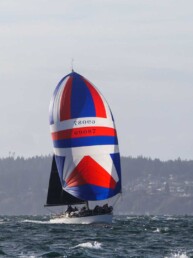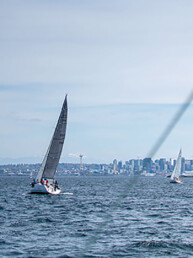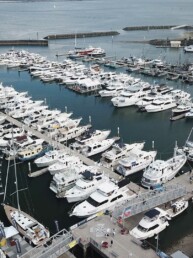
In July 2023, I sailed my 16-foot sailboat 100 miles up Puget Sound as a part of the Salish 100. It was the most adventurous thing I have ever done. Only experienced skippers and boats under 22 feet could participate in the event put on by the Northwest Maritime Center. The seven-day journey began in Olympia, Washington, and ended in Port Townsend.
The purpose of the Salish 100 is to give small boat skippers a chance to test their cruising skills in a challenging environment, share knowledge, make friends, and enjoy the unparalleled beauty of the Pacific Northwest.
Although I’ve always had an interest in sailing, I wasn’t able to pursue it until recently. Southeast Idaho, where I grew up, isn’t known for its maritime culture, and finances also prevented me from buying a boat for a long time. I was able to invest in my interest when we moved to Spokane, which is close to Idaho’s Lake Coeur d’Alene and Lake Pend Oreille, both excellent sailing lakes. I consider myself an “advanced novice” sailor.
My Boat
The first boat I bought, a 22-foot Catalina, was much too big for my experience level and I ended up selling it after a year or so. Next, I chose to build a sailboat. At 12 feet, it was small enough for my skill level and, when finished, provided an excellent sailing experience. After a few years on that boat, I decided I needed something with seats, so I bought my current boat: a 16-foot Pearson Hawk I named Rune.
Pearson Yachts only made about 200 Hawks in the early 1960s. Designed by the famous marine architect Carl Alberg, she has beautiful lines, lots of character, and is well built. I get lots of compliments whenever I take her out.
Rune is a lightweight daysailer at only 600 pounds with a 20-pound centerboard, and sails accordingly. I can take advantage of light winds but have to reduce sail when the wind gets over about 10 knots.
Rune was in rough shape at first, and I’ve spent several years and a considerable amount of money making her both seaworthy and pretty. My biggest investment was new sails, which actually cost more than the boat itself, but the difference they’ve made has been worth it. With a handful of other upgrades, including handmade mahogany rub rails, she’s a prettier boat than when she came off the factory floor.

Preparation
Clay Wright is a friend and sailing mentor, and we decided to sail the Salish 100 together on our respective boats. In fact, my ability to make this trip was entirely Clay’s doing. Not only has he invited me on his 22-foot boat many times and given me countless hours of nautical tutoring, he also convinced the Salish 100 committee to let me participate in spite of my inexperience by promising to act as a companion boat specifically for me. Also, since Clay’s boat has several sleeping berths and mine has none, I could sleep on his instead of camping out.
The Salish 100 was slightly beyond my skill level and considerably beyond my comfort level, so Clay and I prepared for the trip for well over a year. Our practice included a handful of opportunities to heave-to and reef the sails, a procedure that would be critical on the longer trip. I knew I was extending myself by singlehanding a daysailer for a week on big water like Puget Sound as a relatively inexperienced sailor, but that was kind of the point. I wanted an experience that would push my boundaries.
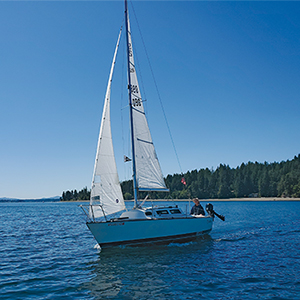
Olympia
We arrived two days early and put our boats in the Sound at Swantown Marina. It was the first time Rune had tasted saltwater since I bought her. About 80 boats registered for the Salish 100, some coming from as far away as Mexico, Pennsylvania, Minnesota, and Texas.
I was anxious, but reasoned myself through it. I knew I had a good boat, I knew I had the essential skills, and I knew what to do and when. I just needed confidence.
Clay and I met a fellow participant, Doc—who had driven up from Baja, Mexico—and helped him get his homebuilt boat, Petunia, in the water. From that time forward, we became buddy-boaters. Doc was a spry 78 years old and had lived a varied life, including owning a marine salvage company in Florida and managing a sailing school in San Francisco. For a short while, one of his sailing teachers was Bernard Moitessier.
Doc rafted his boat to Clay’s and mine for several nights. Petunia was loaded with so much stuff Doc would spend an hour-and-a-half every night making space to sleep in the cabin. Among his belongings, he had a sophisticated solar power system, which proved extremely useful since the battery packs Clay and I had bought were useless.
Day 1: Budd Inlet to Henderson Inlet
The first day provided perfect sailing with 8 knots of wind and water that was an unbelievable shade of blue. Several seals popped their heads up to see what was going on and I saw one small crab swimming along the surface of the water (didn’t know they did that). I also saw pods of porpoises.
The South Sound is much like Lake Coeur d’Alene with lots of inlets and mostly forested shores, so I felt comfortable. I put in a reef near Dana Passage because I thought the wind would be stronger there, but then shook it out as it was not necessary. Coming into Henderson Inlet, Clay anchored his boat and Doc and I rafted-up. Whenever a powerboat sped by, the wakes would knock us around so violently I thought something was going to break. Things settled down after dark. Just the same, it was hard to sleep that first night.
We missed a Salish 100 fleet clam bake that night, because we didn’t have a means to get ashore. Oh well, we dined on rehydrated goo instead.
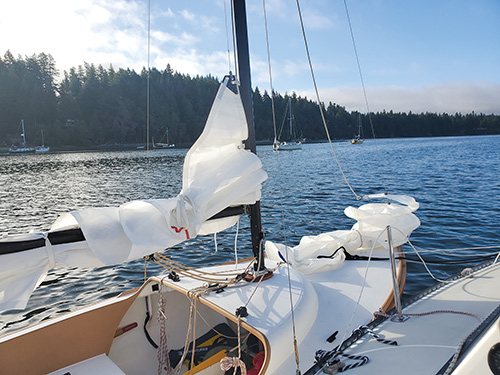
Day 2: Henderson Inlet to Filucy Bay
The second day varied between no wind and about 6 knots in the afternoon. It was very hot but beautiful. Around 2 p.m. one of the support boats, a 50 foot motor-sailer, cruised by to take a picture.
He yelled, “Hey, is that a Pearson?”
“Yeah,” I replied.
“It’s beautiful!” he said.
When a guy in a 50-foot yacht tells you your 16-foot boat is beautiful…now you can die.
Shortly after, the wind died and when I went to start my old Tohatsu outboard, it wouldn’t go into gear. It was not the best to begin with but had been working fine up to that point. Clay towed me toward Filucy Bay until the wind picked up again, and I sailed the rest of the way.
Without a motor, I was in trouble since we were headed through Tacoma Narrows the next day. With ripping currents, it can be dangerous. It was Saturday evening, I was 50 miles from the nearest engine dealer, and my only mode of transportation was a 16-foot sailboat, so buying a new one was impossible. Fortunately, Mark Stone, a skipper on one of the support boats, had a small Suzuki outboard for just such an occasion. He brought it over the next morning and I used it all the way to Port Townsend. Mariners are good folk. They respect independence, but they also recognize that sometimes things go wrong and, when they do, they are happy to help. When I offered to compensate Mark for the use of his motor, he refused saying, “It’s what we do out here.”
Day 3: Filucy Bay to Gig Harbor
The third travel day was big, as we passed through the Tacoma Narrows. The wind was okay in the morning, then died as we approached the Narrows so we motored through, with water churning under the Narrows Bridge. Since I have a special fear of bridge abutments, passing within 50 feet of one should have rung my bell, but I was okay. That little Suzuki just kept chugging along and Rune never faltered even through the gnarly stuff.
Near the entrance to Gig Harbor the wind picked up, giving us about an hour of good sailing before we docked at Arabella’s Landing for the night. Gig Harbor is like Disneyland for boat nuts. The whole town is built around the marinas, and the boat culture is strong. The local boat shop hosted a barbecue for the Salish sailors, and even though it was just a hot dog and a Coke, it was amazing.
The forecast for the following day was a small craft advisory beginning in the late morning. That meant rain and southerly winds up to 25 knots—way too much for my little boat—and I’ll admit I didn’t sleep well that night.
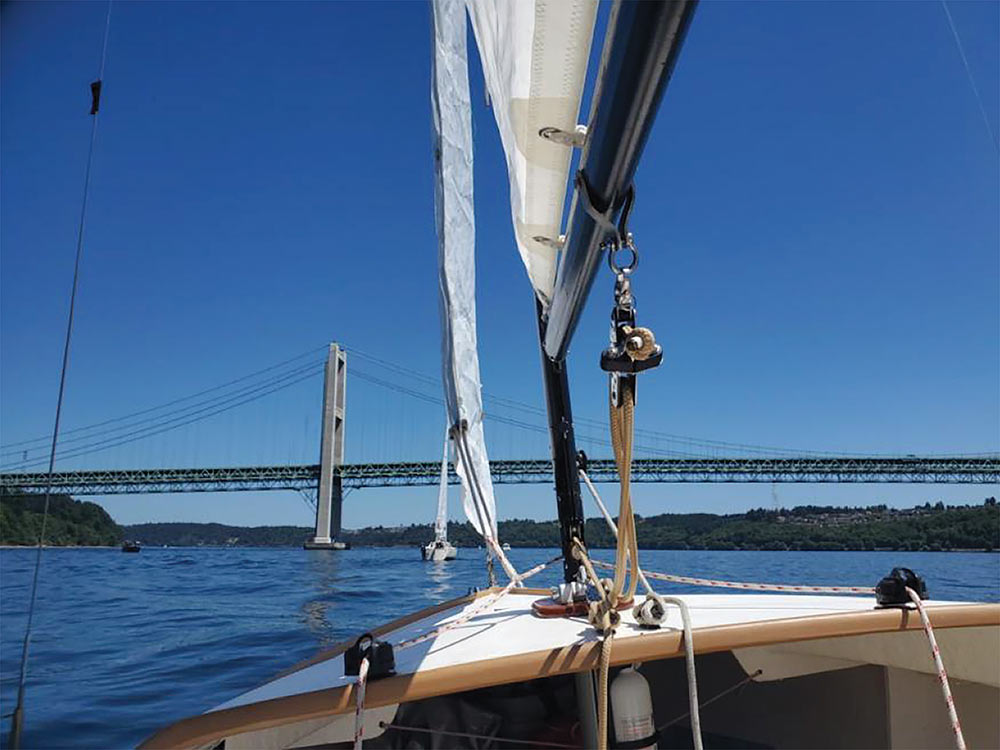
Day 4: Gig Harbor to Blake Island

We left early to try to beat the worst of the weather. Setting out with my foul weather gear on, I was prepared for the worst. Our course took us up Colvos Passage and to Blake Island State Park, and the southerly winds pushed us along nicely. I had my mainsail and jib set wing-on-wing to capture as much wind as possible. But one challenge with a following wind is that you don’t realize how strong it is until you turn into it. By the time we exited the channel, the wind was more than Rune could take. Turning 180 degrees to dodge the Southworth ferry, I hove-to and double reefed the mainsail. That, however, wasn’t enough. Several other boats had dropped their jibs by then, so I decided to do the same. Rune sailed comfortably then, but the wind was howling in the rigging. It felt so good to duck into the relative protection of Blake Island Marina.
Fortunately for us, Doc was concerned enough about the forecast that he motored all the way to Blake Island and secured a place at the public dock. They let us raft our boats together for the night. Others had to anchor outside the marina on buoys. Buffeted all night by wind, waves, and the wakes of passing ferries and freighters, it was a tough night for those folks.
Blake Island felt like a milestone for me. It was real sailing in real weather, and I was managing my little boat by myself quite well. I felt proud.
The thing about Blake Island was the raccoons. Fearless and wicked smart, they descended on the fleet as soon as we landed, making off with anything edible in a furry flash. I even saw one trying to pick the latch on Doc’s boat.
When the rain came in, Clay and I sought shelter in his boat. The wind howled all night long, and the waves rocked the boat even in the protection of the marina.
Day 5: Blake Island to Kingston
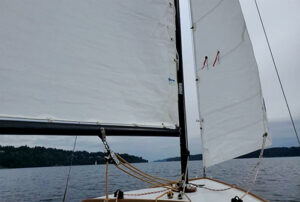
This was our first day on the more open water of central Puget Sound and our primary concern was not being run down by a ferry. Some make speeds of up to 30 knots, very fast for any vessel. Fortunately, the wind from the previous night’s storm was enough to scoot us past them at a good speed.
The other hazard in the larger part of the sound were ships. Commercial traffic stayed mainly in the lanes farther east than we were sailing, but several Salish boats ventured too close and had to be warned to stay out of the way.
Since the winds were either southerly or easterly, the sailing was generally pleasant. Meals underway consisted of whatever I could eat with one hand. Arriving in Kingston, the fleet’s skippers were again treated with a hot dog barbecue, courtesy of the Port of Kingston, and it tasted great. I was exhausted and slept for about an hour after arriving.
Later that night, we ate at a bar and grill near the marina that had some of the best fish and chips I’ve ever tasted. By chance, we sat next to the skipper in the 50-foot motor-sailer who had taken my picture. He was super friendly and far more down-to-earth than I would have expected from a young guy with a boat bigger than my house.
That night was magical. Several people had musical instruments, so folks gathered under a gazebo near the marina office to play and sing songs. They started with a Salish 100 song, and then played anything they could patch together, pulling up the music and lyrics on their phones and singing into the evening. As the sun settled on the horizon, the clouds in the western sky turned an amazing salmon orange. It was the best night of the trip.
Day 6: Kingston to Port Ludlow
The route from Kingston was the most challenging day by far. Getting to Port Ludlow meant passing Point No Point, a promontory that hinders stronger winds coming from Admiralty Inlet, the waterway leading to the Strait of Juan de Fuca and the Pacific Ocean beyond. Although the fleet timed its departure to take advantage of the outgoing tide, the wind was against us, blowing out of the north at 15 knots. The combination of wind against tide resulted in waves about 1.5 feet high—not a problem for the heavier boats in the fleet but a lot for Rune and me.
As I beat toward the point, the wind steadily increased. In order to make as much northward headway as I could, I found myself coming about closer to shore. On one occasion, I tacked only 50 feet from the beach. Seeing that Rune was overwhelmed, I hove-to and started taking in a reef, but then realized that the wind was blowing me ashore! I had to blow the sheets and start the motor quickly in order to avoid being grounded. That was a lesson: always give yourself adequate sea room to make adjustments.
I ended up putting in three reefs within about half-an-hour, two in the mainsail and one in the jib. Although that task is not particularly hard, climbing onto the foredeck of a 16-foot boat bouncing around on Puget Sound was boundary-pushing. I never fell off, but there were close calls.
Even fully reefed, Rune was struggling, heeling hard and not making headway. Whatever forward momentum she might gain from the wind was countered by the increasing height and force of the waves. Concerned that I was about to break something, I decided to drop the jib altogether, but it is very hard to sail to windward without a jib. It was a strange feeling to have tons of wind but to not be going anywhere.
To get past the point, some boats had reached all the way to the eastern edge of the Sound and the shipping lanes. Then, news of a southbound container ship broke over the radio. Although I had really wanted to pass the point under sail, with the wind and waves solidly against me and a container ship headed my way, I decided to call the game.
Turning Rune into the wind, I had eased the sheets and was just reaching for the pull cord on the motor when my phone rang. ‘Not a great time,’ I thought to myself. It was a fellow skipper and new friend who had passed me a few minutes before. “Without a jib, you’re not going to make very good headway. You might want to just motor past the point or you could be out here all day.” Since skippers are careful not to critique one anothers’ decisions, I knew the “suggestion” was more of a warning and appreciated his concern. Even under power, it took the better part of 30 minutes to put the lighthouse at Point No Point behind me, and the waves made for a bumpy ride.
Past Point No Point, the waves decreased considerably, so I hoisted my sails again and reached northwest toward relative shelter. Although Rune was heeling, she was not uncomfortable, and we made good time beating toward Foulweather Bluff in wind that settled down about 10 knots. I followed several boats that had taken the same course and were a mile ahead of me.

Approximately 500 yards from Foulweather Bluff is a shoal marker. The bigger boats in the fleet went around it but, with the tide up, some of the smaller boats went right through. I didn’t want to make another dogleg to go around, so I just kept going. Although I had plenty of depth under the boat, the shallow water over the shoal meant the waves were significantly bigger than any I had seen, and they churned like a giant washing machine. It was spooky, but what a passage! Wave after wave, Rune rose over the crest and fell with a crash, seawater splashing onto the deck and onto my face. It felt more like running a river than sailing.
Beyond Foulweather Bluff, the wind eased more, bringing us easily toward Port Ludlow. I set my sails wide as we passed one, two, then three boats. It had been a hard push for my little daysailer and I was among the last boats to come in. As I pulled into the slip, one of the dock hands took my line and said, “Welcome. Well done, skipper.” Although I’m sure he said that to all the skippers, it rang especially true to me. Managing my little boat in the face of challenging conditions, making important decisions at the right time, pressing on with confidence in spite of setbacks—all of it felt to me like a significant accomplishment.
Once in, the skipper who had called me earlier came up to me. “Dude! I watched you go through those waves over the shoal. It was gnarly! Your boat totally disappeared in the swells. A couple of times I thought you had gone under. Then you’d pop up again a few seconds later!” So that was kind of a rush. Though I never felt like I was in danger—even amid the churning of the shoal—I see now why mariners develop strong feelings toward their vessels. A boat is a cocoon of protection for a mariner, keeping them safe from the mortal peril that surrounds them. It’s a little scary out there, and anything that keeps the sea at bay earns a mariner’s unqualified adoration.
At Port Ludlow, we enjoyed another barbecue. By then, the 40-or-so skippers who had stuck it out that far were feeling great, sharing stories about passing the point, their boats, and sailing techniques. When I mentioned to one skipper that I had to motor past Point No Point, she reassured me: “Oh, there’s no shame in that! Point No Point is nothing to fool around with. Lots of boats motored past it today.” That made me feel better.
The next morning as we prepared to leave, a great blue heron settled in the shallows about 30 feet from me. I watched him for a few minutes snatching a breakfast of minnows from the reeds.
Day 7: Port Ludlow to Port Townsend
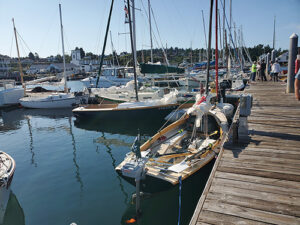
There was light wind for our final day jaunt up Oak Bay, through a small passage, and into Port Townsend Bay. The breeze died around 10:30 a.m. so we motored for a couple of hours. Since one of the boats in our company was having engine problems, we took it slow to make sure they got through the Port Townsend Canal.
At first it was all rather disappointing, then we got through the passage and into Port Townsend Bay. Port Townsend is very much a seaport, and working our way north through the bay it became very clear that we had graduated to “big water.”
The wind was northerly at about 10 knots and the waves were not as big as they were coming around Point No Point, so it was a pleasant sail. Rune sailed to windward nicely as we zig-zagged almost directly north, then east, dodging the ferry and enjoying the final leg to Point Hudson Marina.
As the ocean swell from the strait and Admiralty Inlet rolled beneath us, freighters passed by a mile or two to the north and the sun lit the waves in sparkles as far as I could see. At this point, I knew what Rune could handle and didn’t feel the need to reef. She was heeled hard over, but that’s where she was designed to sail and where she sails best. It felt great to be in big water on my little boat, perched on her beam and gobbling up the sea like some old clipper ship.
Once Rune was secured in Point Hudson, I reached into the cuddy cabin where I had stowed my Salish 100 baseball cap. Though I’d been given the hat in Olympia, I didn’t want to wear it until I had finished. I wanted to earn that honor. Now, I took my old cap off and put the new one on. I had earned it.
I know this kind of trip would be small potatoes for many people but, for me, it was a big deal. I was not an experienced sailor and I did not have a heavy boat that could cut through the wind and chop like some did. Every day tested the limits of both my boat and my confidence, forcing me past psychological confines that life had set for me at an early age. Having proven those boundaries to be false, I feel now much like a new vessel—a new bottle into which I can pour new wine, a new perspective about who I am and what I can do—a new me.
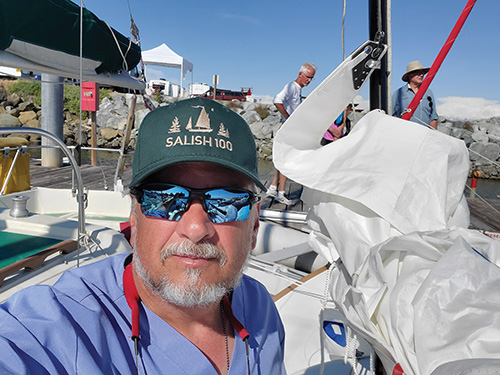
Brian Holloway lives in Spokane, Washington, and primarily sails on the mountain lakes of Idaho.

